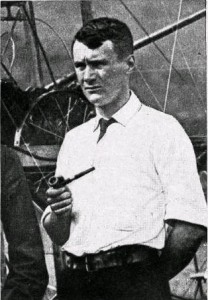
Lt. Thomas Selfridge
“Uh-oh!” It was a simple statement uttered by a man who was about to die. Pilots tend to do that – which is a way of recognizing they will say something very prophetic just before crashing. Usually it is a phrase more dire, most of the time with the use of profane words. One of the most poignant last utterances came from the cockpit of Pacific Southwest Airlines, Flight 182. An unidentified member of the flight deck crew voiced the last words on the cockpit voice recorder following a midair collision with a Cessna 172 over San Diego. The tape closed with the simple statement, “Ma, I love you.”
In 1908, the fledgling aeroplane was new to the world. While Orville showed off the capabilities of their new invention to the US Army, Wilbur was in France doing the same with the French government. Unlike Orville’s tepid reception by the US government, the French accepted Wilbur with open arms and great enthusiasm.
On the afternoon of September 17, 1908, more than 2000 people had gathered to watch Orville Wright fly his aeroplane. Lieutenant Thomas Selfridge would accompany the now famous flyer. The purpose of the flight was further investigation by the military regarding the suitability of using aircraft in the military. For the Wright brothers, a lot was at stake. While a pilot in his own right, Selfridge would accompany Wright as an observer, there to witness and further analyze the practicality of heavier than air fixed wing aircraft for the US Army.
A few minutes after five in the afternoon, Wright and Selfridge took to the air in the Wright Flyer. They climbed to 150 feet above the grounds, circling four-and-a-half times around the field. Wright was content with the performance of the Flyer at the start of the flight.
Orville made the observation later in his writings that the aircraft was flying smoothly and seemed to be working better than on previous flights. Things were going so well, he decided to make his circuits of the field larger. Once the decision was made, he heard something from behind, turned, and looked. He saw nothing amiss, but decided to secure the engine and make a landing.
No sooner had he made this decision that, as he would later write, “…two big thumps, which gave the machine a terrible shaking, showed that something had broken…” This led to an uncommanded right turn and a sudden pitch down, almost to the vertical. This happened at 5:17 in the evening.
At this point, Lt. Selfridge, who had not said anything until now, simply said, “Uh-oh.”
Lt. Selfridge was born on February 8, 1882 and at the time of his death 107 years ago today, he was only 26-years-old. He had been in the Army for five years having graduated from West Point in 1903, the same year as the Wright’s first flight on the beaches of Kitty Hawk. He finished in the top third of his class, a class that that included General Douglas MacArthur. Selfridge was the son and grandson of two rear admirals of the US Navy.
After graduation, he started his career in the artillery and in 1907, transferred to the Aeronautical Division of the US Signal Corps. The Army soon posted him to Fort Myer, VA, which was the location of Orville’s crash, on which he was the hapless passenger. This crash made Selfridge famous in American aviation history. In it, he became the first passenger in the world ever to die in a plane crash.
The Army would later determine the cause of the crash to be a split propeller. When it came apart, it tangled in the aircraft rigging causing the out-of-control situation that pitched the plane nose-first into the ground.
The crash threw both men from their sitting positions forward into the leading wires, gravely injuring them, Selfridge more severely than Wright. During the crash, his head struck wooden components of the airframe, breaking the base of his skull. Selfridge died after surgery three hours later, having never regained consciousness.
Orville Wright spent the remainder of September and all of October in the hospital. His left leg was broken in the crash, as were several ribs. He also suffered facial injuries and bruises. He would, however, go on to fly again.
The Army buried Selfridge in Arlington National Cemetery, adjacent to Fort Myer, not far from the crash site itself.
-30-
©2015 J. Clark
Subscribe by email (Remember subscribing is a two part process – you have to respond and verify via email after you receive the confirmation request.)
Note: Email subscribers, please go to my blog to view vids


Interesting write-up Joe, I always enjoy reading those, “And that’s the rest of the story” type of readings.